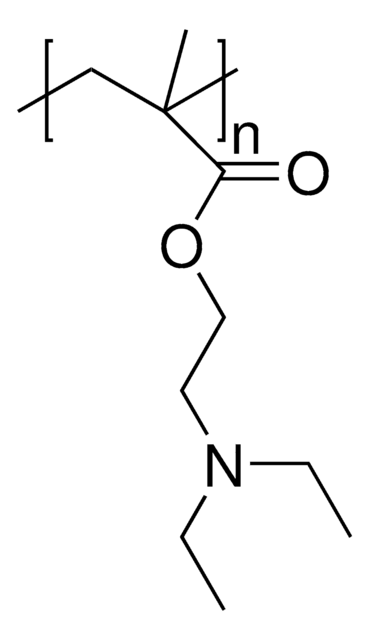910457
Poly(2-(diisopropylamino)ethyl methacrylate)
average Mn 10,000
Sinonimo/i:
Hydrophilic, PDPA, pH sensitive, pH-responsive
Autenticatiper visualizzare i prezzi riservati alla tua organizzazione & contrattuali
About This Item
Formula condensata:
(C12H23NO2)n
Codice UNSPSC:
12162002
NACRES:
NA.23
Prodotti consigliati
Forma fisica
powder or solid
PM
average Mn 10,000 (by NMR)
average Mn 10,000
Colore
white to faint yellow
Ind. polidispersione
≤1.3 (by GPC)
Temperatura di conservazione
2-8°C
Applicazioni
Poly(2-(diisopropylamino)ethyl methacrylate) is a pH-responsvie polymer. pH-Responsive polymers are a group of stimuli-responsive polymers that can respond to solution pH by undergoing structural and property changes such as surface activity, chain conformation, solubility, and configuration. The term “pH-responsive polymers” is commonly used to describe polymers having ionisable acidic or basic residues whose ionization depends on solution pH. The physical properties of the polymer, such as its chain conformation, configuration, and solubility, can be tailored by manipulating the pH or ionic strength. These unique properties of pH responsive polymer systems consequently make them very useful in various applications such as drug delivery, gene delivery, sensors, surfaces, membranes, and chromatography.
pH-sensitive polymer systems combined with nanotechnology could be utilized as an alternative strategy to traditional targeting systems to overcome major problems in current chemotherapy represented by non-specific tissue distribution of the drugs, tumor heterogeneity, and multidrug resistance (MDR) against anticancer drugs.
pH-sensitive polymer systems combined with nanotechnology could be utilized as an alternative strategy to traditional targeting systems to overcome major problems in current chemotherapy represented by non-specific tissue distribution of the drugs, tumor heterogeneity, and multidrug resistance (MDR) against anticancer drugs.
Codice della classe di stoccaggio
11 - Combustible Solids
Classe di pericolosità dell'acqua (WGK)
WGK 3
Punto d’infiammabilità (°F)
Not applicable
Punto d’infiammabilità (°C)
Not applicable
Certificati d'analisi (COA)
Cerca il Certificati d'analisi (COA) digitando il numero di lotto/batch corrispondente. I numeri di lotto o di batch sono stampati sull'etichetta dei prodotti dopo la parola ‘Lotto’ o ‘Batch’.
Possiedi già questo prodotto?
I documenti relativi ai prodotti acquistati recentemente sono disponibili nell’Archivio dei documenti.
pH-Responsive polymers
Kocak G, et al.
Polym. Chem., 8, 144-176 (2017)
Jing Xie et al.
Macromolecular rapid communications, 38(23), 1499-1499 (2017-10-05)
Since diabetes mellitus has become one of the most serious threats to human health, researchers have been designing new drugs and developing new technologies to control the blood glucose level (BGL) while improving patient compliance. In addition to the traditional
pH-sensitive polymers for drug delivery.
Huh K M, et al.
Macromolecular Research, 20(3), 224-233 (2012)
Girish Kumar Tripathi et al.
Current drug delivery, 8(6), 667-677 (2012-02-09)
Helicobacter pylori reside in the gastric mucus layer and at the mucus-epithelial cell interface wherein access of antimicrobial drug to the infection site is restricted both from the stomach and from the gastric blood supply. The aim of the present
Themis R Kyriakides et al.
Journal of controlled release : official journal of the Controlled Release Society, 78(1-3), 295-303 (2002-01-05)
Cytosolic delivery from endosomes is critical for those drugs that are susceptible to attack by lysosomal enzymes, such as DNA, RNA, oligonucleotides, proteins and peptides. Therefore, we have designed pH-sensitive, membrane-disruptive polymers to enhance the release of drugs from the
Il team dei nostri ricercatori vanta grande esperienza in tutte le aree della ricerca quali Life Science, scienza dei materiali, sintesi chimica, cromatografia, discipline analitiche, ecc..
Contatta l'Assistenza Tecnica.




![N-[3-(Dimethylamino)propyl]methacrylamide 99%, contains MEHQ as inhibitor](/deepweb/assets/sigmaaldrich/product/structures/295/145/6b4aae15-7cb5-4b7b-9c06-8e6d24e50951/640/6b4aae15-7cb5-4b7b-9c06-8e6d24e50951.png)



![[2-(Methacryloyloxy)ethyl]trimethylammonium chloride solution 75 wt. % in H2O](/deepweb/assets/sigmaaldrich/product/structures/316/612/66b0f4cf-d060-427d-b4f5-e8fab3e5cffe/640/66b0f4cf-d060-427d-b4f5-e8fab3e5cffe.png)